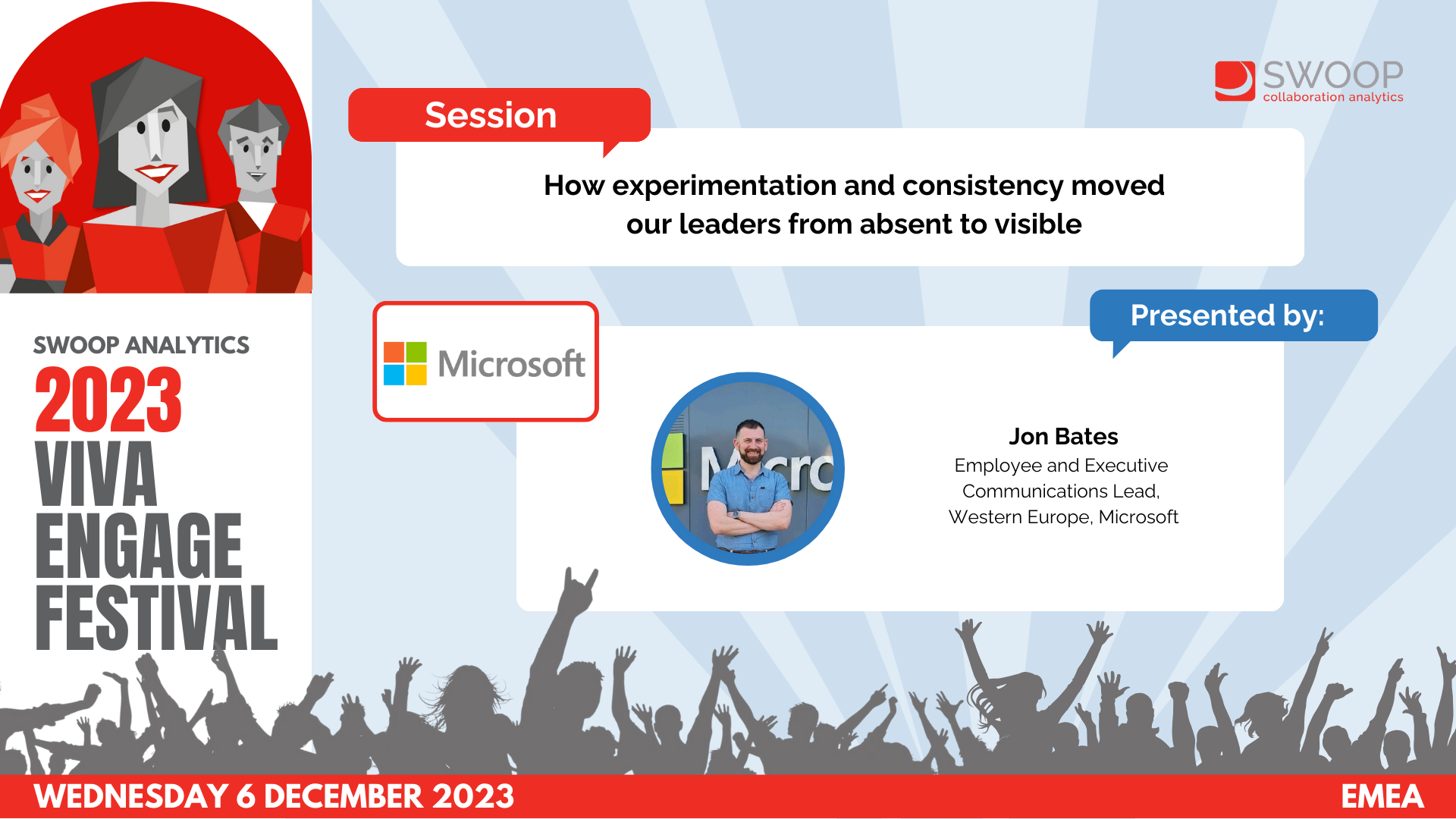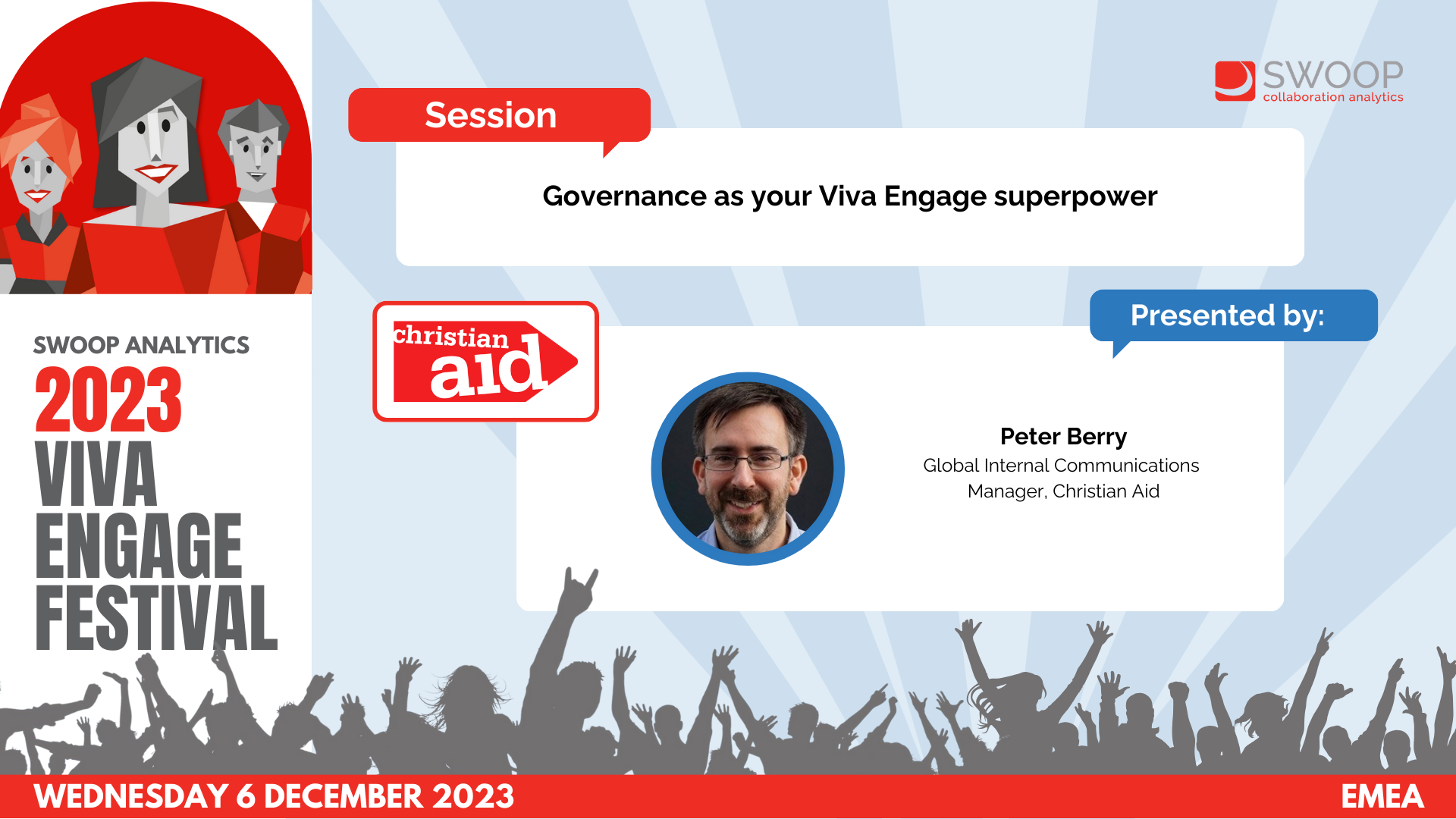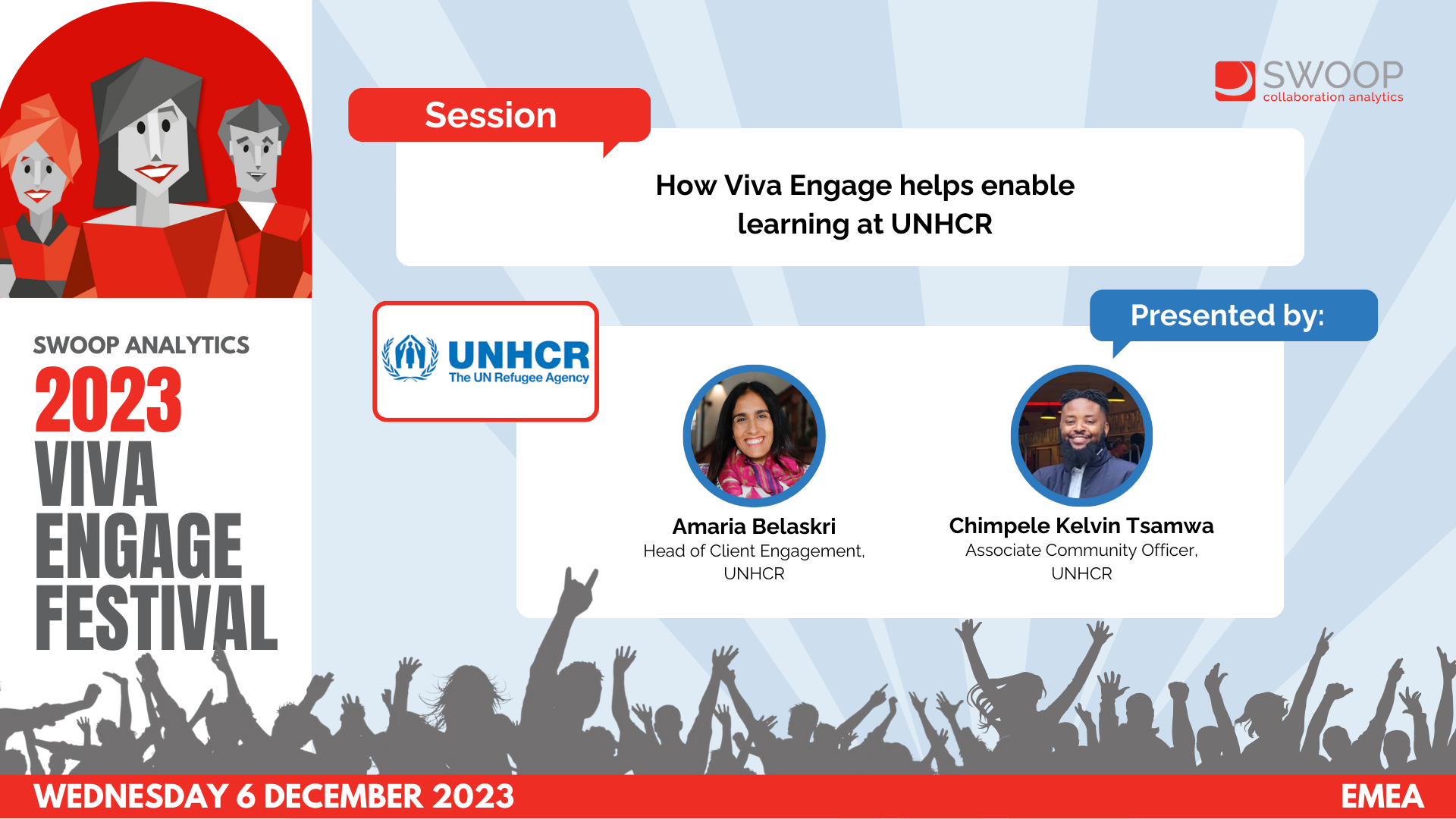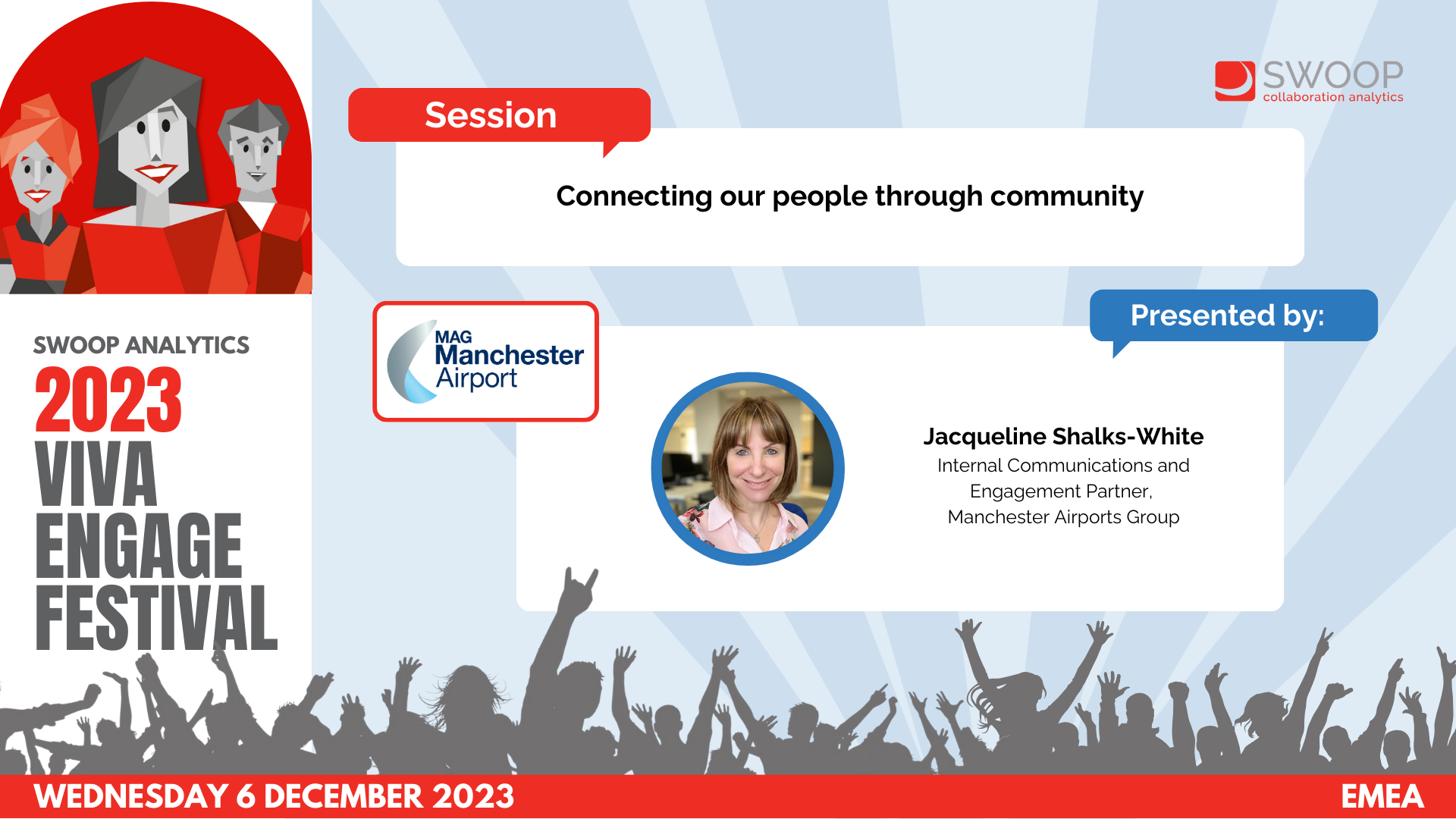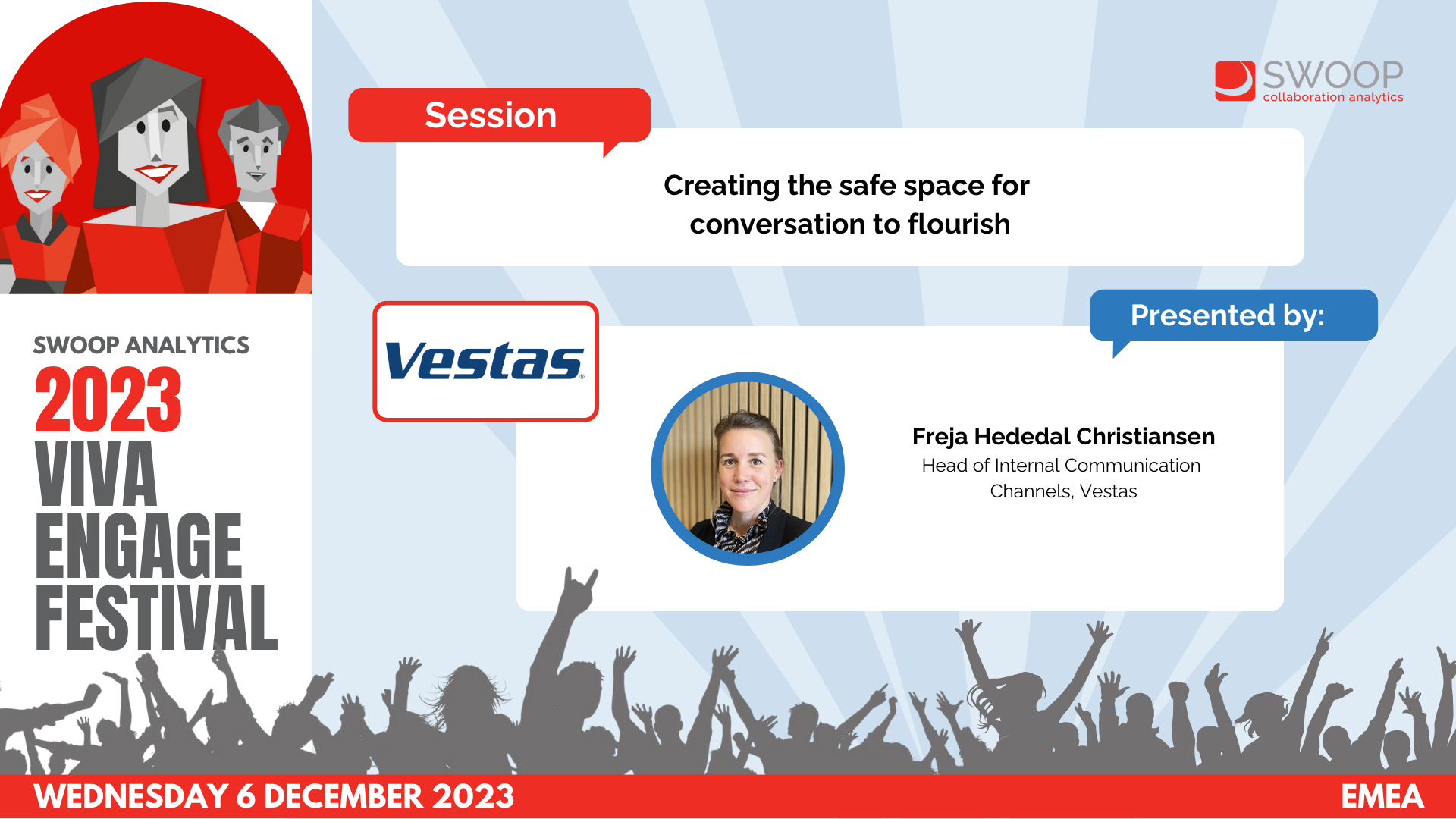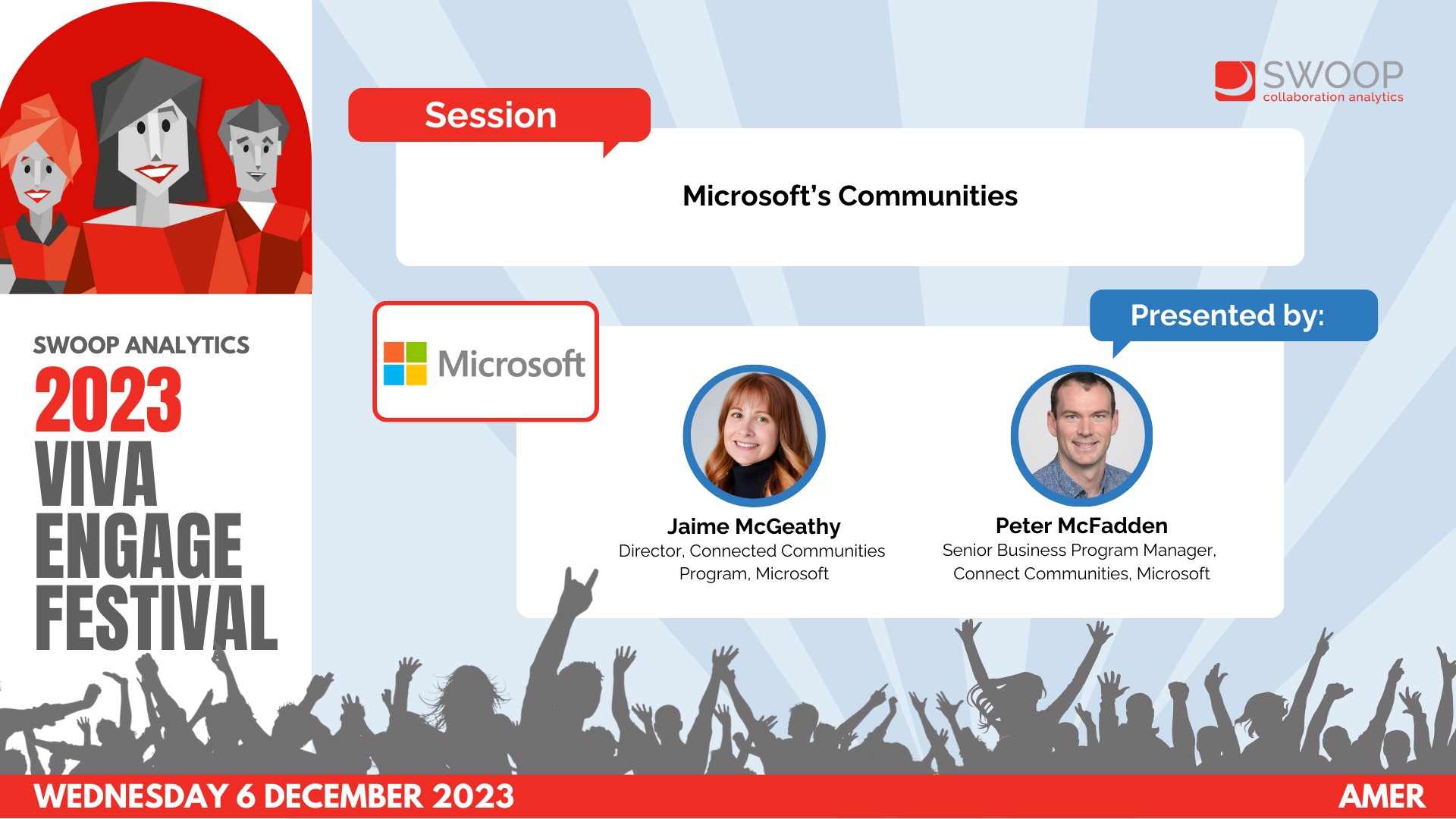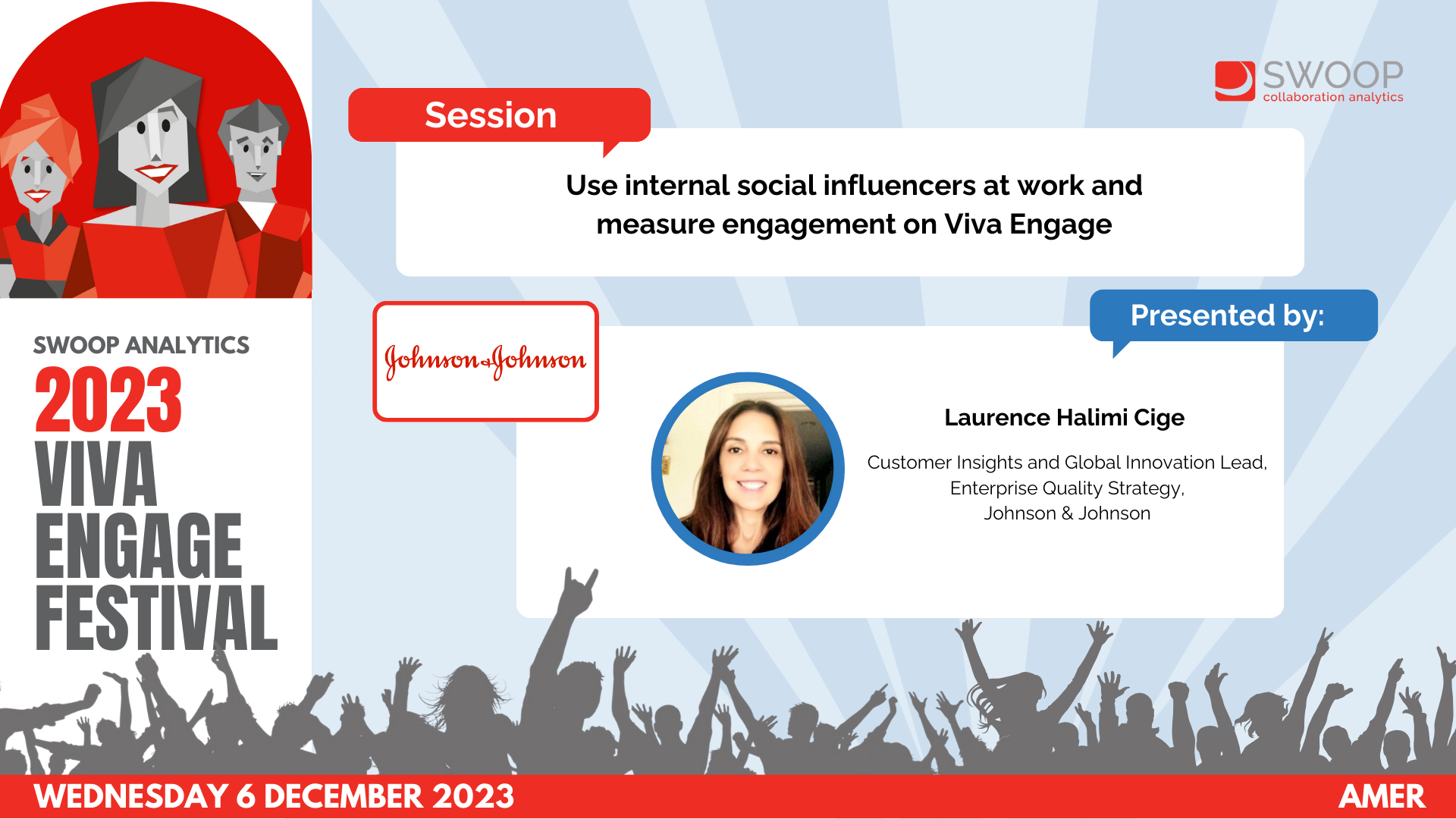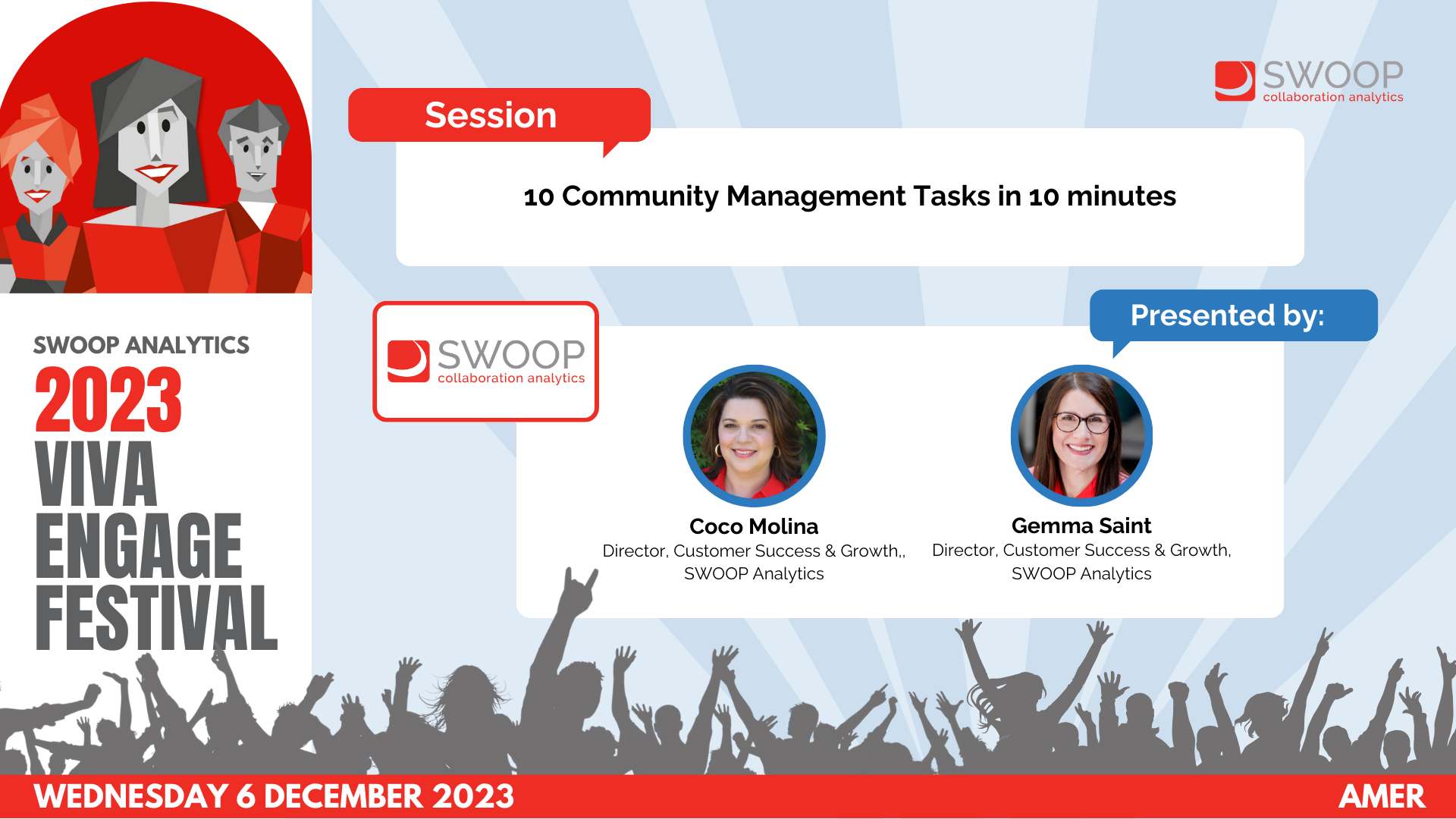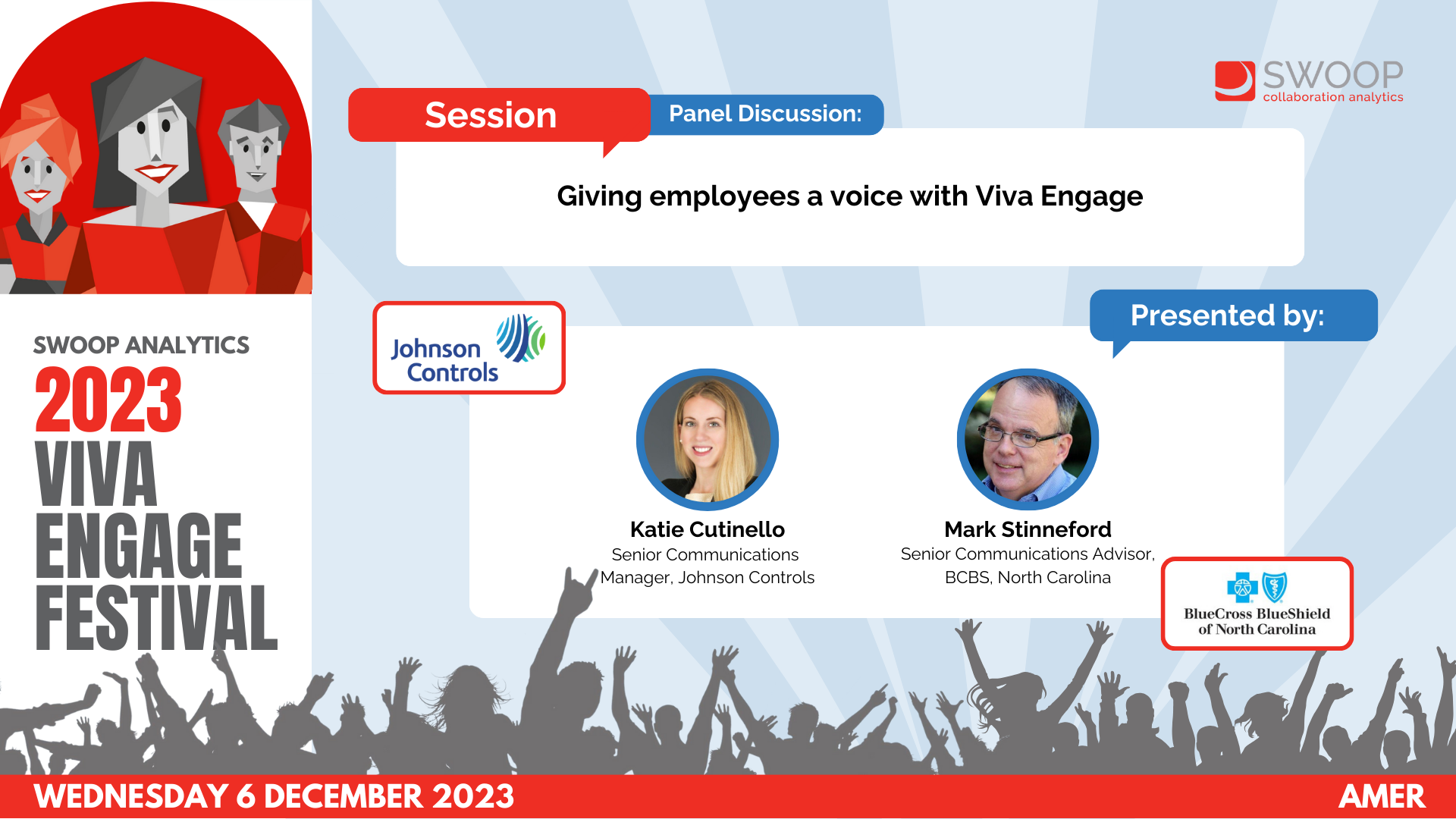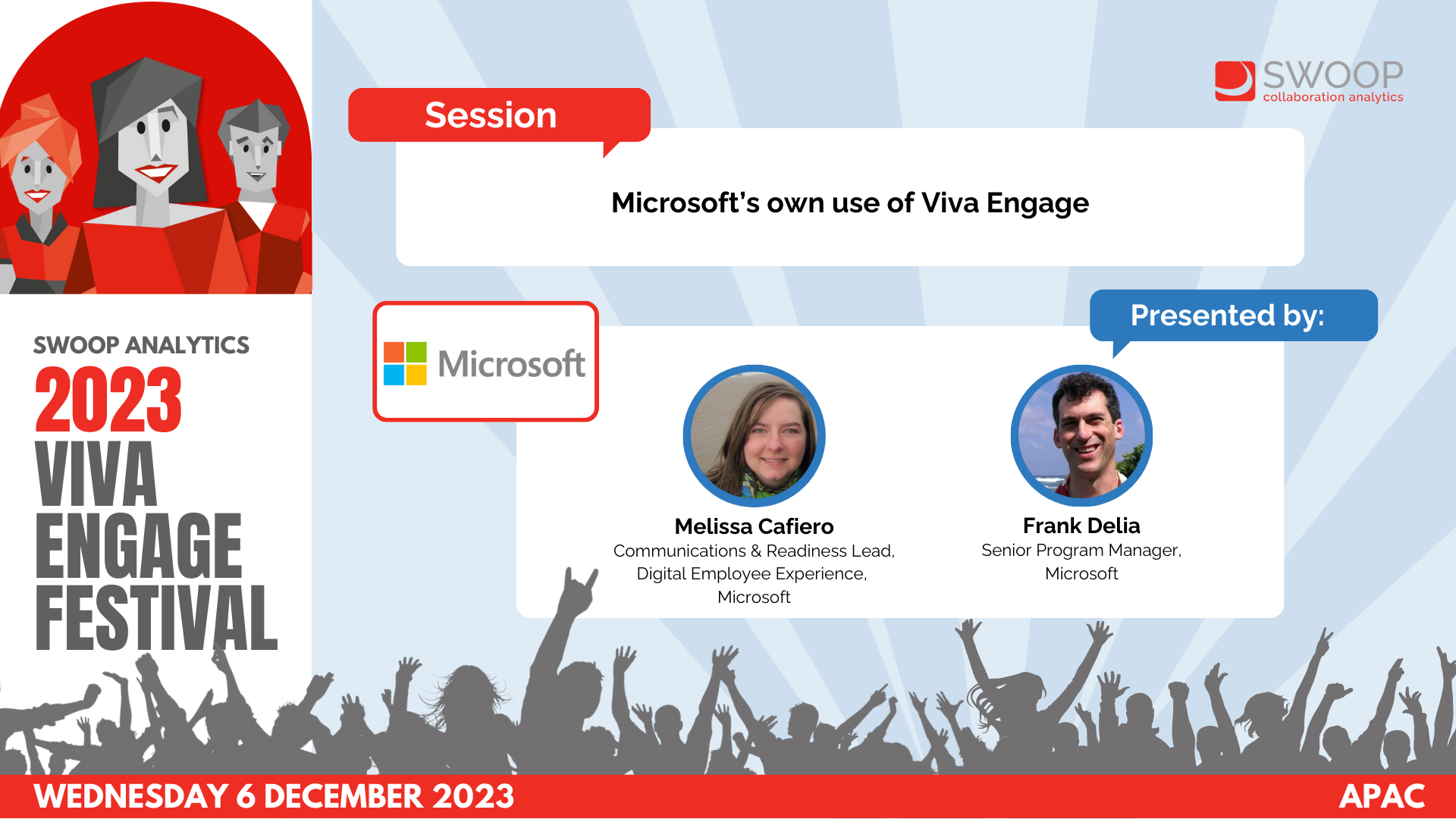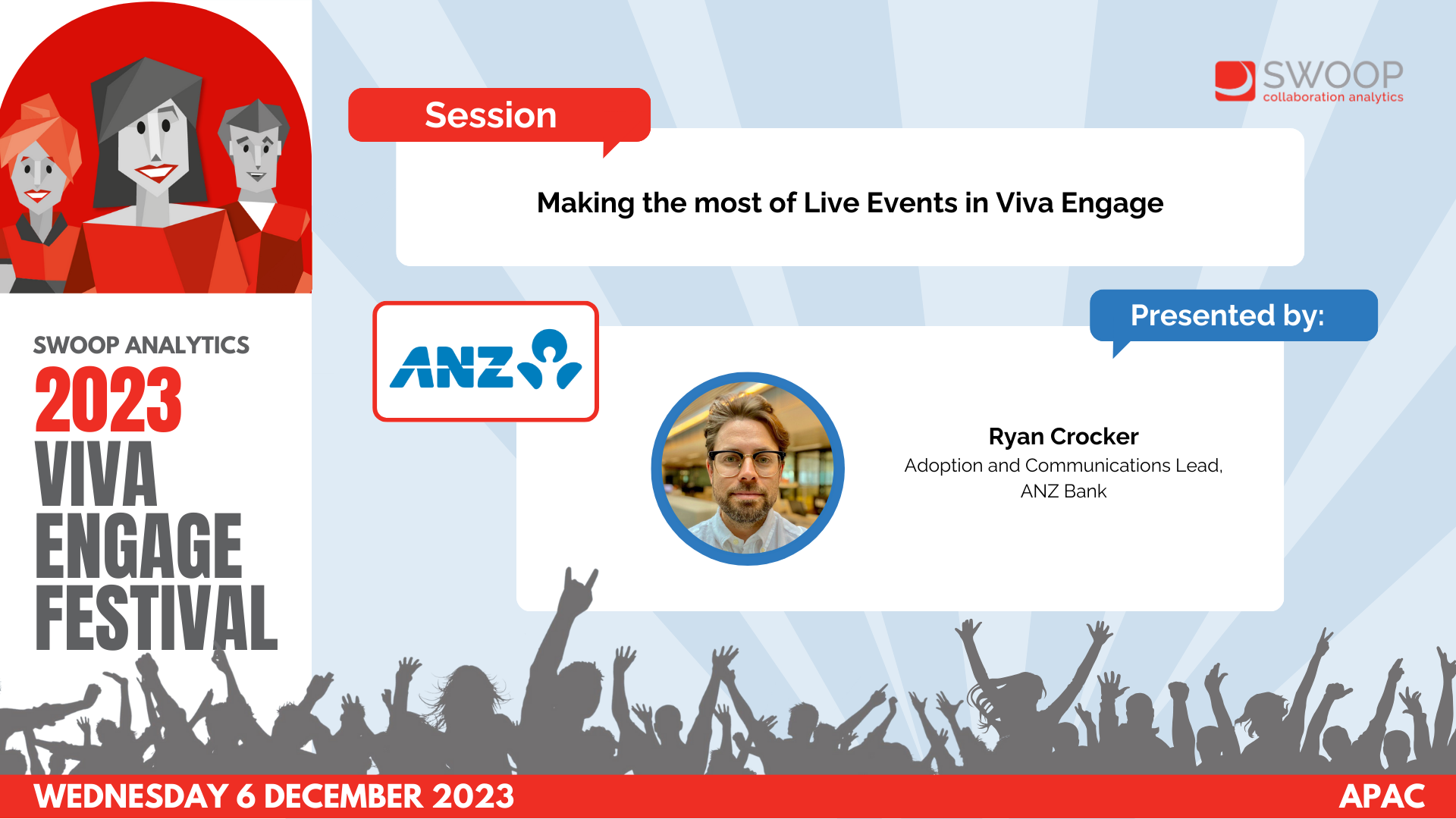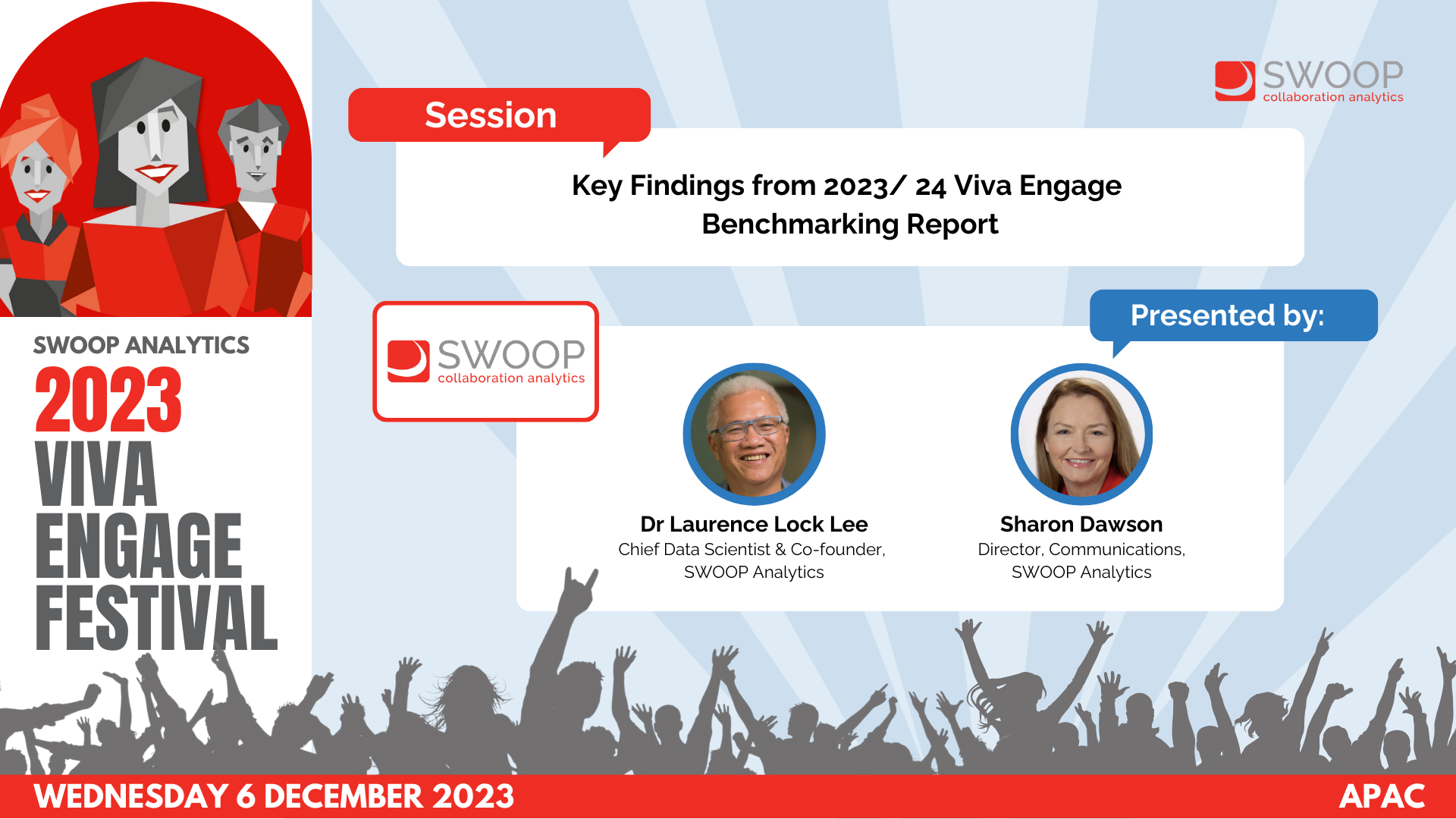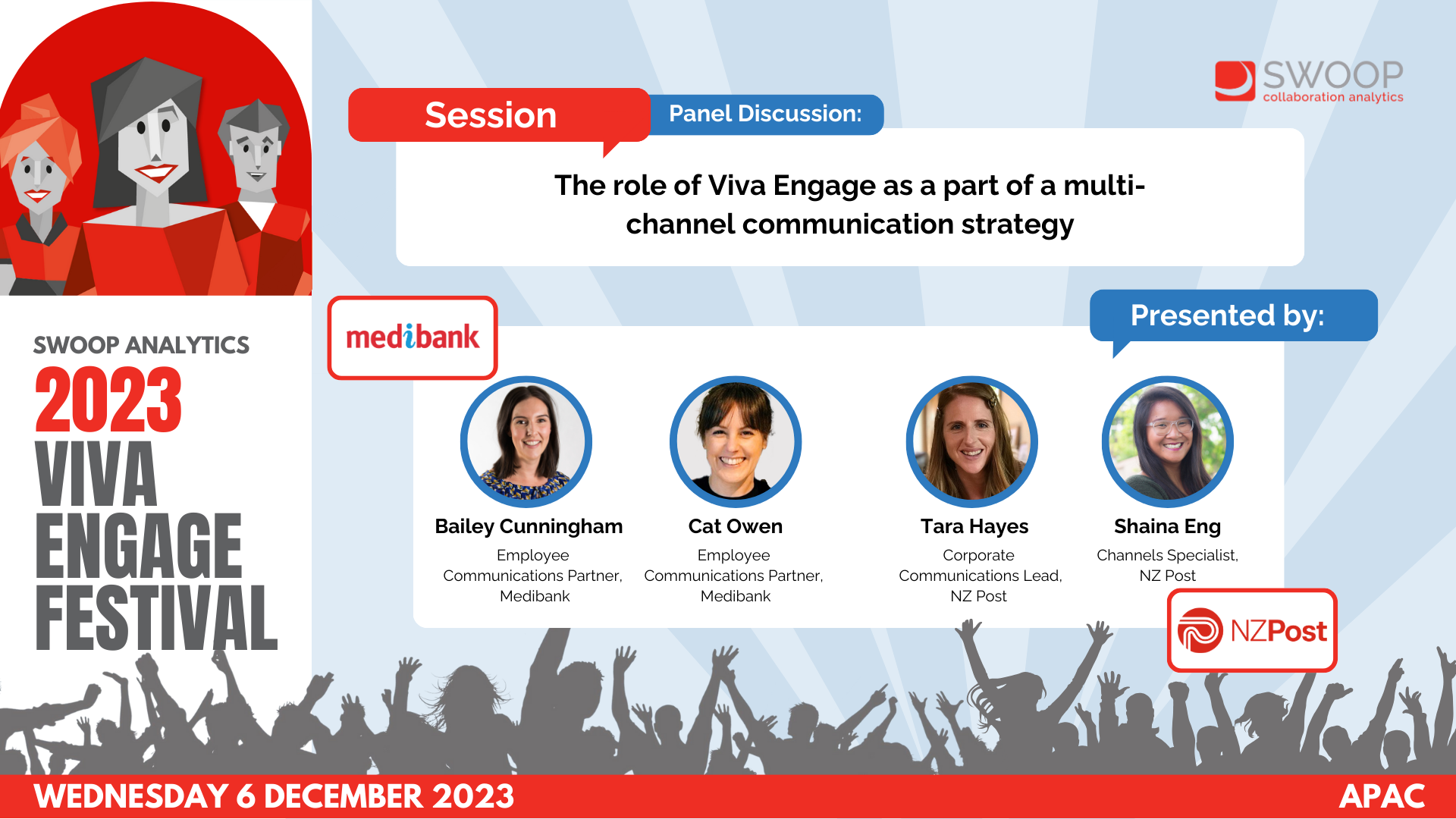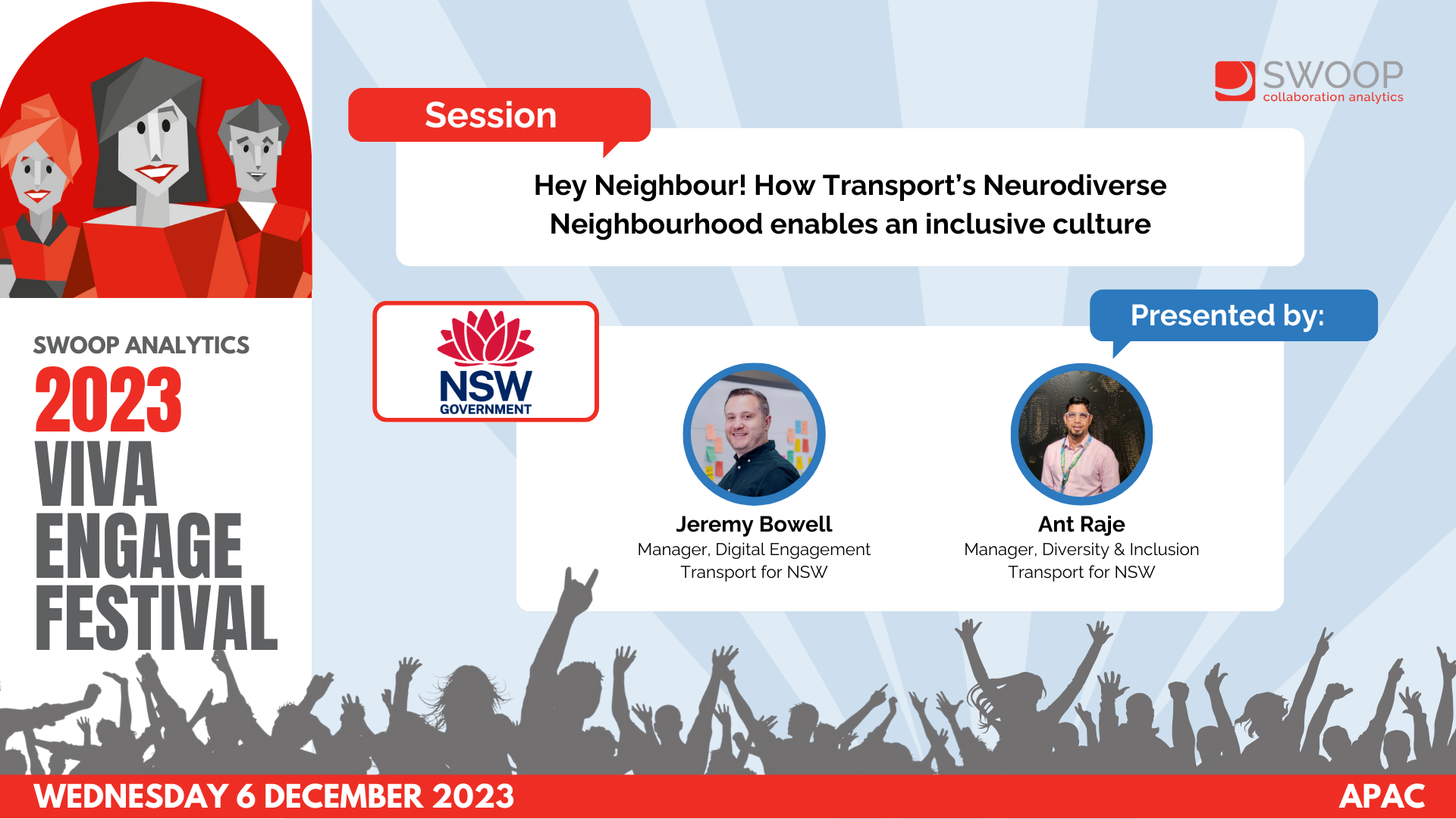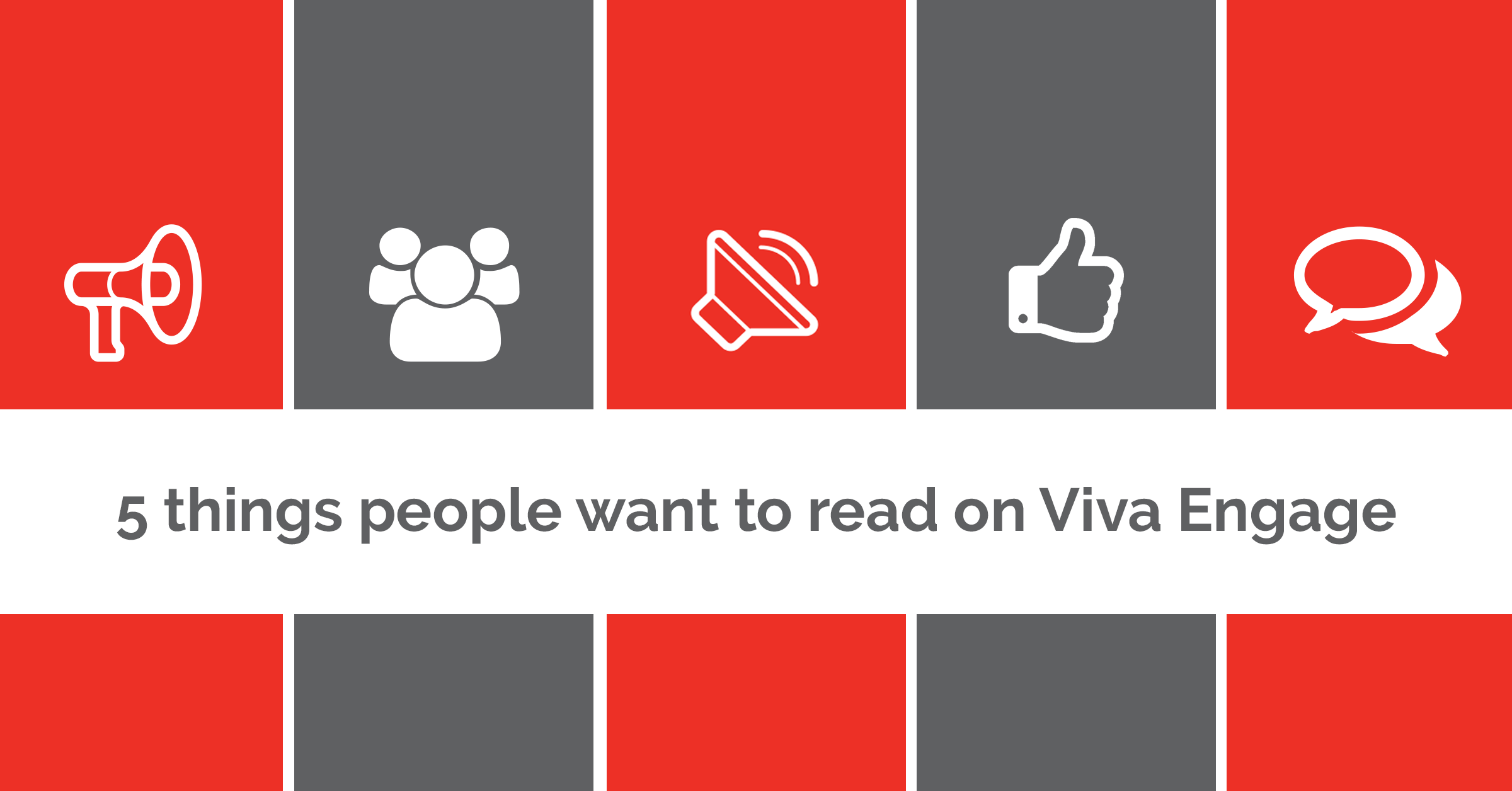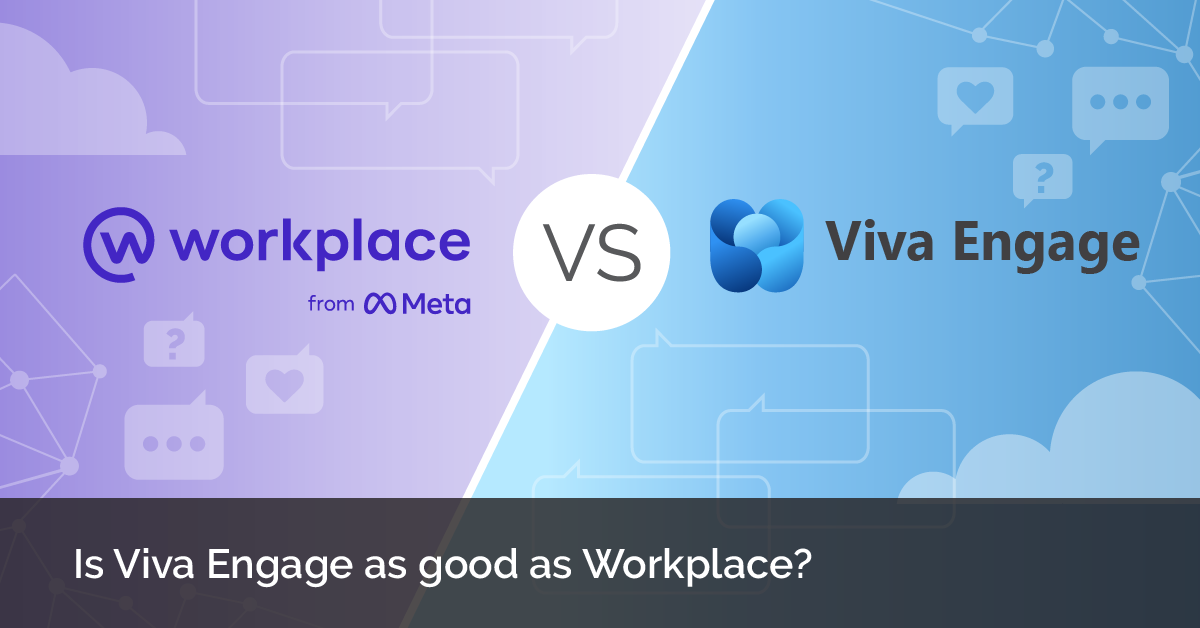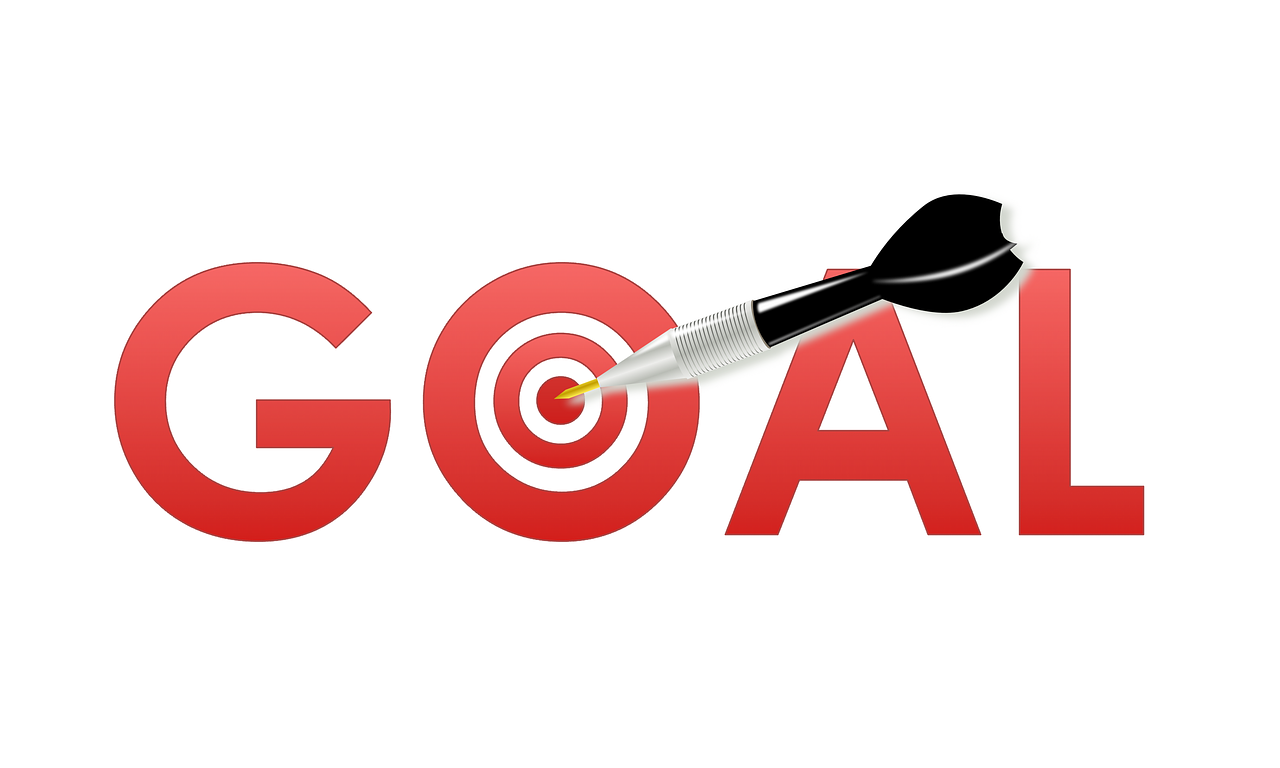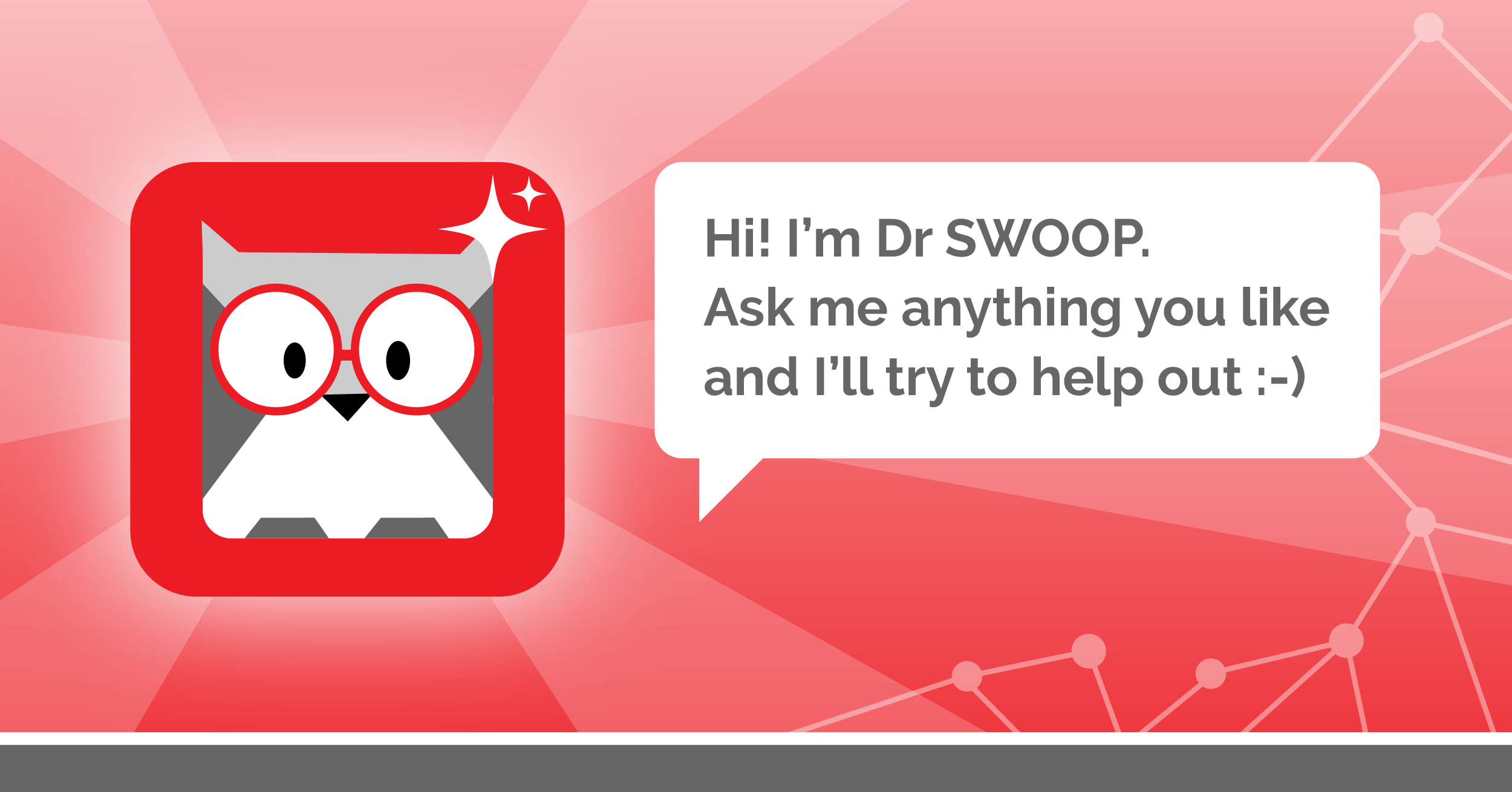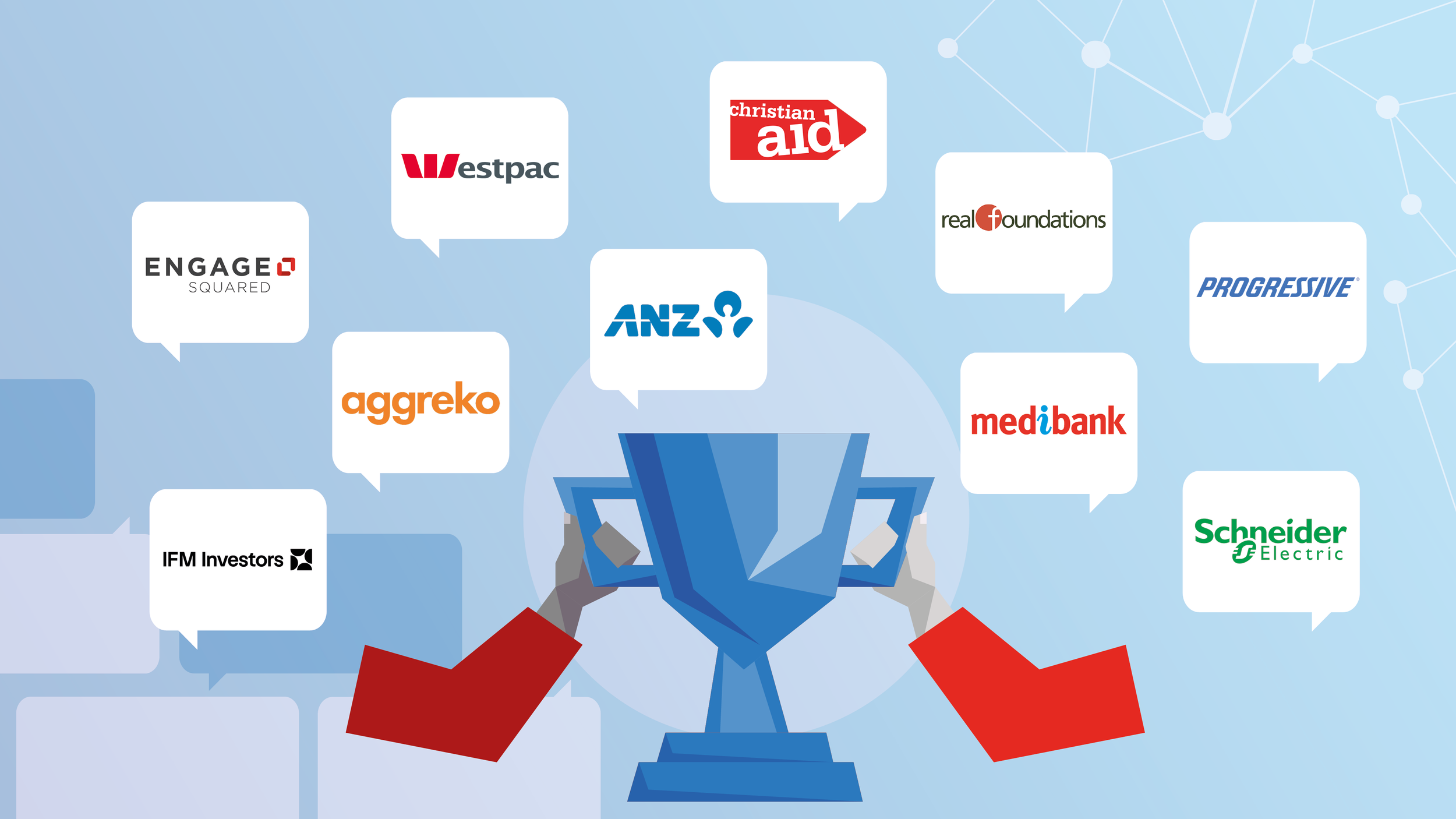SWOOP Analytics: 2023/24 Viva Engage Benchmarking Report
APAC | Viva Engage Festival 2023
Join Dr Laurence Lock Lee and Sharon Dawson in showcasing the data from our most recent Viva Engage Benchmark Report, with some truly compelling case studies from Medibank and ANZ! The 2023/24 Viva Engage Benchmark Report is available for free download right now!
-
Now about a month or so ago, SWOOP, we released the latest Viva Engage benchmarking results and today we have the report authors here ready to run through the key insights for you. We have our Chief Data Scientist, Dr. Laurence Lock Lee, or Laurie, and our Director of Communications, Sharon Dawson, and they're here ready to deep dive into some of the top insights from this year's analysis.
So in that case, I'm going to hand straight to Laurie. How did everything unfold in this year's report? So thanks, Emily. So straight into it.
This is actually our ninth benchmarking report. So for Viva Engage, or formerly Yammer, as you can see, we've got lots of organisations, nearly 100, and 5,000 active communities that we analysed. We purposely picked a time period around where we are in this migration out of the COVID period into the hybrid period, and whether we're in the office or whether we're not, because we're just interested in what the trends were going to be as we move through this hybrid period even, if you like.
For those that aren't familiar with the way we do benchmarking, we don't do surveys, we analyse what everybody does. So we basically analyse what people do rather than what they say they do. It is fairly unique.
It's called Workplace Analytics now, so it has a name. Those of you that may have been introduced to Viva Insights from Microsoft, that's also Workplace Analytics. But interestingly, they do not use Viva Engage signals in their work.
They mainly concentrate on meetings and chat and email. So it is quite unique that we have, and the fact that we've got nine years of data, we can certainly track trends over several generations, if you like, and the sorts of things that have happened over the last nine years. So let's move on to the next slide, Emmeline.
So I think we're going to run a poll. Yeah, this is where we're going to put everybody to the test. So in part of our benchmarking is we look at the percentage of interactive users that are using Viva Engage.
So these are people in the six-month period that we benchmarked who have either posted, replied or reacted to posts. So, Frank, can you run this poll for us, please? And we're going to see if who's read the report. If you've read the report, you'll know the answer and what your thoughts are.
What's interesting is you can see that there's no option above 50%. So I don't know how you guys feel about that, if that works out with your experience as well. And I can tell you looking at the results coming through, a lot of people seem to have read the report.
But it's interesting, look at that, 12, 11% think it's as low as 9% of active participation in Viva Engage. I can tell you, thankfully, it is significantly higher than that. So do you want to, I'll hand over to you, Laurie, and we'll share the answers.
Yeah, well, the answer was 27%. So that means 27% of everybody who's capable of posting or reacting on Viva Engage have actually done it in the last six months. So now you might say, well, that's a, some might think, well, that's a pretty good number.
It's a pretty poor number. What I can say is that we were building up pre-COVID up into the mid-30s. It has actually dropped since COVID, and I've got some views about that, but we'll talk about that a little bit later.
But basically, we've got people reading in Viva Engage. Now that really jumped to, we've got 85% here. That's pretty much par for the course of most of the other channels, I might say, in terms of reading.
That really happened when the Yammer at the time was integrated with Outlook and with Teams, and that boosted the readership, but it didn't boost the active participation, right? So what we have is 58% of employees that are reading, but not really actively participating in conversations or anything like that. So clearly, there's both a challenge and an opportunity there. So let's go to the next slide, Emily.
Yeah, so now you start to think about, well, what is it that people can read things and yet won't participate necessarily? And there's a lot of things that go into that, and we could talk, we could have a whole seminar on that. But clearly, it is a step of stage to go from reading to writing, to actually being confident enough to post a reply. Certainly reacting is probably the easiest thing to do, but this participation rate counts reacting as well.
So I think there's a combination of skill development, but also peer activities. So when your friends or your colleagues are actually doing this sort of thing, you'll do it as well. So there's many strategies that we could walk you through and how we might build that up.
I must say that 27% is the average. So we certainly had some with participation rates at the 9% or below. And I think our best was up in the 60s, the high 60s.
So there is a big range. So you know it's possible to get way up there, close to 70%. So let's move on again, Emily, just to the next one.
Now, I guess this is the thing about, you know, why do we think that this sort of why are we seeing this percentage interactive sort of trending downwards? My take on this is that, you know, when Yammer was first formed, and even when Microsoft acquired Yammer, I think it was in 2012 or something like that, the natural owners of Yammer were communities type people or knowledge management people. But when COVID came along, you know, Viva Engage went ballistic with internal communications and executives being able to reach out to the organisation in this very disruptive period of 2020 or something like that, 2021. And the internal communications people really came to the fore then.
So we saw a migration of ownership, if you like, of Yammer and now Viva Engage from that sort of knowledge management community sort of space into the internal communication space. So of course, what we saw was more internal communication influence on what was happening. So you did see more broadcasting type things, more content driven sort of stuff.
But having said that, you know, sort of, you know, I've heard here already that, you know, the internal communications people are certainly the ones that are leading the way, value, know what the value of conversation and two way communication is. And that's very encouraging. So looking at the actual communities themselves, you know, so we measured 5,000, nearly 5,000 active communities across those 97 organisations.
This is just a quick flash up of how we assess the communities and it's very comprehensive. So you can see there's something like 16 different measures that goes into this. You can see the factors, participation, engagement, responsibility and so forth.
And then last year, we even added thriving, which we built as energy and growth together in our assessment. And we kept it for this year. So when we measure the communities, they're clearly high performing.
So and as I said, they're analysed very forensically, if I might say so myself. So can we get to the next slide, Emily? So let's talk about one of those. Yeah, I'm going to jump in here, Laurie.
So within our benchmarking report, as Laurie said, we benchmarked 97 organisations worldwide. And we do two sort of separate benchmarks. One, we look at every organisation's entire Viva Engage network.
So their top performing communities as well as their poor performing communities. And Medibank, who we just heard from Bailey and Kat, ranked number two worldwide for medium sized organisations on that measure. We also did a deep dive into just under 5000 communities.
And that was measured, Laurie, I think I've got this right. It was measures like two way relationships, connections, sentiment, growth, consistent activity, and more during the six month period. So they're quite active in the community.
Pretty much all of those factors that I showed in the previous slide. So very comprehensive assessment. Yeah, so Medibank's retail Viva Engage community ranked number two worldwide.
So you've actually just heard from Kat and Bailey. And Kat and Bailey, if you're still there, please jump in and share some more with this. But primarily this Medibank community, so it was called Medibank retail up until I think a month or two ago.
And it's now called Medibank community. Now I know Kat just at the end of her talk was referring to this same community. We spoke with the head of all the retail stores across Medibank, Andrew Carlson.
And he had such great experiences to share with us. So basically this community, it's used for daily updates across about 85 stores across Australia. And a lot of it is used for recognition of employees and work anniversaries, celebrating even birthdays, business successes, and also health and wellbeing initiatives like the R U OK? Day.
Interestingly, some of the other communities that Kat and Bailey were referring to earlier, like that what if community, you know, which was any idea, am I right, Kat? Any idea about ideas that could make work better for you or ways you can bring more joy and happiness into your work life? And there was another community, Work Reinvented, that were also within the top about 50 of the 5,000 communities we measured. So this Medibank community, it connects the 400 frontline team members at Medibank, along with about another 300 or so Medibank employees and executives. So, yeah, just the daily updates and especially these work anniversaries, they just really create these conversations, which is what we found in the previous slide that Laurie was referring to.
It's these conversation-based communities that are the high performing ones. So Andrew Carlson was saying, there's some quotes here from him about, you know, it makes everybody feel equal or like a real person. And he said it allows colleagues to build trust despite being geographically dispersed across all of Australia.
And they really have some meaningful discussions and outcomes for the business. And Andrew was sharing a story with us the day before we spoke with him. He'd been in the Melbourne headquarters.
And there was a post in this Viva Engage community about a team member's 20th work anniversary. And he walked into this meeting and there was a senior leader who was actually on the phone to the frontline worker because he'd seen the post about this 20th work anniversary. So he picked up the phone to ring that store to speak to the employee and congratulate them on that anniversary.
So he was saying for the frontline team, it's really a chance for them to feel like, you know, they can be part of the frontline and see what's happening in the stores as well. Obviously, another benefit of this community is for senior executives to post photos, videos, their thoughts about visits to the store and connect with the frontline workers. What was interesting from Andrew's point of view, so he said he's on Viva Engage and in this community and other communities every day, but he likes to take a step back.
So when he goes and does his store visits, which is, you know, when we were speaking to him, he was actually driving, he'd just been at one store and was driving to the next. He encourages employees within those stores to take photos themselves and write about their experiences of his visit rather than it all coming from him. And what he makes the effort to do is then jump in and reply and tag people into those posts as well.
So you're getting their perspective on it. So yeah, this is just an example of making communities conversation-based and connecting people. So I'm going to hand over to you for our next finding, Laurie.
Yeah, so interesting, as I said, we've been doing this benchmark for nine years. From the very early days, we decided we needed to break up the organisations into sizes because we found that if you're the smaller organisation, I think the smallest was just over 100 people, but, you know, let's say below say 1,000 or 1,500, it was easier to outperform with our sort of metrics. And then we had a middle size and a large, so we thought it was fair to do that.
But last year for the first time, a non-small organisation was our top and that was Westpac New Zealand. And they were a mid-sized organisation, I think 3,000 to 4,000 active users on Engage. But this year, we got someone from the large size, which is over 8,000.
In fact, this organisation is close to 50,000 active users. So back to you, Sharon, to tell their story. And they were the best overall.
The largest one, so it's ANZ, and another Aussie New Zealand, APAC-based organisation. And you're actually going to hear from Ryan, who is it the next session, Emily, or coming up anyway later today? Coming up soon. Yeah, yeah, so don't miss that one.
So it's an incredible achievement for ANZ to be ranked number one, as Laurie said, almost 50,000 employees. But it's something that didn't happen overnight. And I want you all to, you know, take heart in that.
This is something that they've actually worked towards. So it's taken years of nurturing to get to this position. And you'll see there from 2019, working their way up to 2023, how they've been ranked in our benchmarking.
So we've been really fortunate to be able to ride this Viva Engage and Yammer journey with ANZ. And I really think that ANZ is a role model for any organisation to follow. So it started, well, our journey with ANZ and them being recognised as one of the high-performing organisations in our benchmarking started in 2019.
And it really started with the CEO, Shane Elliott at the helm. So he was using Yammer to connect with his employees in really genuine two-way conversations. And he was taking the time to understand what was important to his employees.
So this was prior to COVID-19. And we've got a case study that I think Friend's going to share in the chat, but he was really asking employees their opinions on Yammer. And importantly, he was listening to their answers and responding to those.
So in 2020, we all know COVID-19 hit, the world of work changed, and Yammer went berserk at ANZ. Once again, Shane Elliott was at the helm and he was doing a webcast every week. And then the link to that webcast was shared back into the Yammer Q&A community for everyone to join in the conversation and to ask questions.
Now from 2020 to now, Viva Engage has really become a part of the culture among ANZ employees. What's interesting is the CEO, Shane Elliott, has now really taken a back seat because while his leadership was needed in those early years, now almost every leader and the majority of employees know that they come to Viva Engage and the network is thriving. So in our benchmarking report, there's a great example of a case study about a phishing simulation email that was sent to employees a few months ago.
And what was interesting, so it was like a security test and someone in the security team actually blew the cover on this fake phishing email by warning everyone about the scam in a Viva Engage community. So a lot of people question, why would someone spoil it by revealing the details on Viva Engage? When in fact, that's best practice because at ANZ, everyone knows to come to Viva Engage to share their knowledge. So if this was a real life situation, that's where people would go to and could save the organisation.
We all know about the breaches that have been happening, not at ANZ. And just, here's a few quotes from Ryan who you're going to hear from later. This is just to give you all heart that this doesn't happen overnight, that you become the number one organisation in the world for Viva Engage.
It is a journey for you to go on, but it's still growing day to day. So I'm going to hand over to you, Laurie, cause we're getting short on time. Okay.
Emily, if you could just go straight to the bar chart, I think I can talk to that one. There, this one here. So, as I said, we've got years of data, if you like, and we've been looking at this trend principally from around the beginning of COVID through to today.
The ones that, this chart pretty much says the things that are increasing and the things that are going backwards, right? So this year, the mentioned index or the tagging, things that tag just went ballistic. It's always been on growth. So people are learning how to tag, but for some reason between 2023 and 2022, it went up 35%.
I can't fully explain that. At the other end though, we see things like the threads per user in particular, the engage a persona, the two-way relationships, the curiosity. These things are related to conversation.
And I find that a little bit more disturbing in terms of the trend of that. I have explained that a little bit in terms of this migration of ownership, but, and I guess what I'm feeling is that this will turn around and I'm even hearing it with the internal communications, if you like, the new owners of Viva Engage, appreciating the value of conversation. Let's go through to the maturity chart, I think, Emily, the next one, I think here.
So this is the maturity model that we've been using since for the whole nine years from the beginning. We have modified the labelling on the major phases to content, conversations and outcomes. And I guess within each of these, there's sweep measures, if you like.
Now, I guess what we're seeing is that, in some ways we were climbing up the conversation part with the knowledge management community sort of focus. We've gone, if you like, with a new owner that's more content centric internal communications. We may have even, if you like, regressed in communication, but we've brought more people into the platform.
So, you know, we've got 85% of people in now, was when we started, we were probably only looking at 30 or 40%. So I'm not saying that's a regression, but what I'm saying is we're getting a bigger crowd now that we can bring forward into the conversations. And it's heartening to actually hear internal commission communications, people talking about how to generate better conversations.
And of course, once you do that, you build connections, you build trust, you build relationships, and then you start to solve really hard problems and start innovating. That's where the real big impacts of Viva Engage can happen, the tangible outcomes. So I think let's hand over to the last because we're running very short.
Yeah, we're super tight. So just a big congratulations to our collaboration champions from this year's benchmarking report. Number one in APAC for large size organisations was ANZ.
We had Westpac New Zealand as the number one for medium size organisations and Engage Squared were the top performing APAC small size organisation. And then for our communities, as we mentioned, we had Medibank and IFM Investors who were new to the benchmarking champions list this year. So congratulations to everybody.




